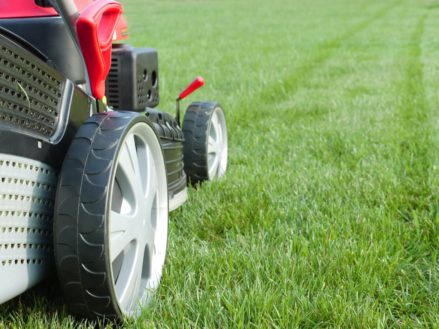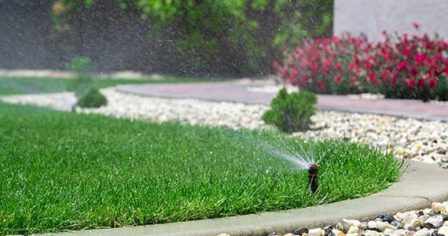There are some people out there who really enjoy mowing their lawns. They take great pleasure in spending hours meticulously spacing their passes, edging to perfection, and blowing the clippings off of sidewalks and walkways. Then, there are the rest of us, who are determined to mow less.
For those of you reading this who would rather spend time with your family, golfing, hiking, doing ANYTHING else, keep reading about Plant Growth Regulators (PGR’s) and find out how to reduce your mowing.
How they work
There are two types of Plant Growth Regulators. One type works by actually halting the vertical growth of the plant itself. They contain a product that interrupts cellular division in the plant. This can be detrimental to the plant health, causing it to decline.
The PGR that we use for our clients works differently. It inhibits gibberellic acid (GA), which is responsible for cell lengthening in plants. Simply, it shortens the vertical growth of the stems and cells in the plant itself. This means the plant to continue to grow, but the growth will not be quite so “vertical.” This allows the turf to continue to fight off certain diseases and maintain overall health.
What are the benefits
So, why have a PGR applied to your property? Here are some great reasons…
Obviously, Less Mowing!
The less a plant grows vertically, the less mowing you have to do. Some PGR’s have shown 30% – 50% reduction in the number of times you need to mow while the product is working.
While you might have to mow less frequently, you will also likely have fewer clippings. Cutting the lawn while the grass isn’t as tall leads to fewer clumps, better mulching, and less thatch.
If you’d like to get your weekends back, you should consider this option.
Turf Density
All that growth in the plant isn’t stopping all together. The grass is still going to grow. But that energy needs to be sent somewhere! So, lawns with a TGR program tend to grow thicker. In essence, you’re trading vertical growth for lateral growth.
Studies have shown that turf actually grows thicker and healthier when PGRs are applied.
Shady Conditions
Homeowners with shady lawns should also consider using PGR on the turf. It sounds crazy at first – slow the growth of an area that is already thin and spotty? What are you thinking?
Think about the above point, though – it helps the lawn spread out. If you have an area that is thin, encouraging the existing turf to spread sideways will help it fill it.
This practice is something many professional turf managers will use for sports venues. Say a football or baseball stadium is hosting a concert. An application of PGR prior to covering the field (to prevent damage, or for stage set-up) will help the turf recover more quickly. Because it encourages lateral growth, it helps offset damage caused by lack of sunlight. This allows the field to be recovered to safe use for athletes more rapidly.
 Better Color
Better Color
Of course, there’s an aesthetic benefit to this, too. When PGR’s are applied to your lawn, the color improves.
Here’s an analogy. Let’s say you have 24 ounces of Coca-Cola Classic. You also have two bottles – a one-liter and a two-liter bottle. You have a task to fill both bottles to full. But, you only have 24 ounces, and a liter is a little over 33 ounces.
If you fill the bottle with 24 ounces of Coke, and had to fill the rest with water, which bottle is going to appear darker? The smaller, more compact bottle, obviously. And why? It’s the same amount of Coke in the bottle, it’s just less “spread out” or less “diluted.”
It’s not a perfect analogy, but you get the gist – smaller cells mean more chlorophyll in a smaller space. A higher concentration of chlorophyll in a smaller area equals a darker color.
Reduced Watering
A further benefit of having PGR applied to your lawn is improved drought resistance. Basically, Growth Regulators improves the way the lawn uses water. This can allow you to water less if you have an irrigation system. This is helpful if you live in a place with a water restriction, or if you’re simply worried about the water bill.
Frequently Asked Questions
We tend to get some questions about using PGR’s on a lawn. Here are some of them…
Do I still have to fertilize?
Yes, you still need to fertilize your lawn when using a PGR. The fertilization does NOT necessarily cause explosive plant growth. What it does is keep the plant healthy. Temperature, rainfall, and grass species are far greater factors in determining when and how much grass grows.
Proper fertilization and weed control are still vital with Growth Regulators. The plant didn’t stop growing; it is simply growing sideways instead of vertically. This means it still needs fertilizer to maintain plant health.
Will it wash off?
No, it should not. Many PGR’s will adhere to plant material quickly. The products we employ are rain-fast within one hour, meaning they will not “wash off” in a rain event.
Will it hurt my other plants?
No, it will not. Any overspray might affect the color of the flowers on your trees or shrubs. The GA-inhibitor will simply cause the plants to grow denser, but will not harm them. In fact, many nurseries already use these products to display plants that are more compact and attractive looking.
If you have questions about using a PGR on your lawn, we’d love to speak with you. Please Contact Us for more information.
The post How to Mow Less: Growth Regulators appeared first on Tomlinson Bomberger.
from Tomlinson Bomberger http://bit.ly/2KcFxa3

No comments:
Post a Comment